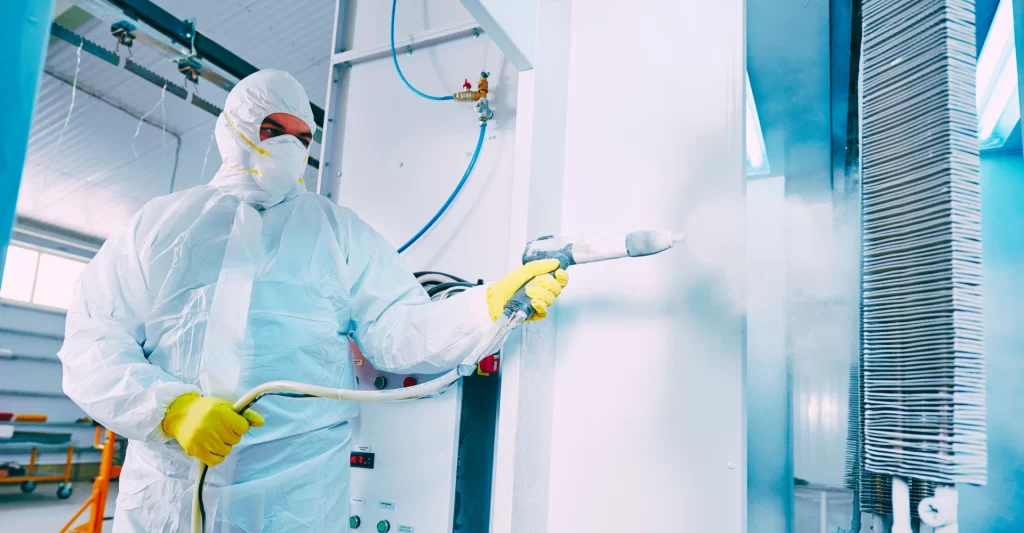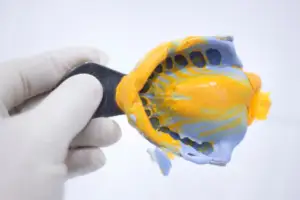CMC in Coatings: An Overview
Carboxymethyl cellulose (CMC) is a versatile cellulose derivative that I have found to be widely used in the coatings industry due to its unique properties. In this section, I provide an overview of the role of CMC in coatings, the types of coatings that utilize CMC, and the benefits associated with its use.
Role of CMC in Coatings
CMC serves multiple roles in coatings, acting primarily as a thickener, stabilizer, and film-forming agent. Its ability to modify viscosity is crucial in ensuring that coatings have the appropriate flow characteristics for application, whether by brush, roller, or spray. By controlling viscosity, CMC helps in achieving uniform film thickness and preventing sagging or running of the coating.
Additionally, CMC enhances the stability of coatings. It prevents the settling of pigments and fillers, ensuring that the components remain evenly dispersed throughout the coating formulation. This stabilization is critical for maintaining the consistency and performance of the coating over time.
CMC also contributes to the film-forming properties of coatings. It aids in the formation of smooth, continuous films that adhere well to various substrates. This property is particularly important for protective and decorative coatings, where the integrity of the film is essential for providing the desired appearance and protection.
Types of Coatings That Use CMC
CMC is used in a variety of coatings, each benefiting from its specific properties. Some common types of coatings that incorporate CMC include:
- Paints and Surface Coatings: In both water-based and solvent-based paints, CMC improves the application properties and stability of the paint. It ensures that the paint spreads evenly and adheres well to surfaces, resulting in a high-quality finish.
- Textile Coatings: CMC is used in textile finishing processes to enhance the hand feel, appearance, and durability of fabrics. It acts as a binder and film former, improving the overall performance of textile coatings.
- Paper and Board Coatings: In the paper industry, CMC is used to coat paper and cardboard, enhancing their printability, smoothness, and strength. It also improves the resistance of paper products to moisture and other environmental factors.
- Ceramic and Construction Coatings: CMC is utilized in ceramic glazes and construction coatings to improve workability and adhesion. In construction, it helps in modifying the flow properties of mortars and renders, making them easier to apply and more durable.
Benefits of Using CMC in Coatings
The inclusion of CMC in coating formulations offers numerous benefits, making it a preferred additive in various applications:
- Improved Texture and Consistency: CMC provides coatings with a desirable texture and consistency, ensuring smooth application and a uniform finish. This property is especially important for decorative coatings where aesthetics are crucial.
- Enhanced Adhesion and Film Strength: CMC enhances the adhesion of coatings to substrates, ensuring that the coatings remain intact and effective over time. The improved film strength provided by CMC also contributes to the durability and protective qualities of the coating.
- Better Dispersion of Pigments and Fillers: CMC helps in the even distribution of pigments and fillers within the coating, preventing agglomeration and settling. This results in consistent color and performance of the coating throughout its application and lifespan.
- Cost-Effectiveness and Sustainability: CMC is a cost-effective additive that offers significant performance benefits at relatively low usage levels. Additionally, as a biodegradable and renewable material, CMC aligns with the growing emphasis on sustainability in the coatings industry.

Key Properties of CMC for Coatings
Carboxymethyl cellulose (CMC) is widely utilized in the coatings industry due to its distinctive properties that enhance the performance and application of various coatings. In this section, I delve into the key properties of CMC that make it an indispensable additive in coatings: viscosity and thickening properties, film-forming capabilities, stability and solubility in water, and compatibility with other coating ingredients.
Viscosity and Thickening Properties
One of the primary reasons I use CMC in coatings is its ability to modify viscosity. CMC acts as a rheology modifier, providing control over the flow and application characteristics of the coating. By adjusting the concentration of CMC, I can achieve the desired viscosity, ensuring that the coating can be applied smoothly and uniformly.
The thickening properties of CMC are particularly beneficial in preventing the sagging and dripping of coatings during application. This property is crucial for achieving a consistent film thickness, which is vital for both protective and decorative purposes. Additionally, CMC’s viscosity modification helps in maintaining the stability of the coating by preventing the settling of pigments and fillers, ensuring a homogeneous mixture throughout the application process.
Film-Forming Capabilities
CMC’s film-forming capabilities are another critical property that enhances its utility in coatings. When I use CMC in a coating formulation, it aids in the creation of a continuous, cohesive film upon drying. This film-forming ability is essential for providing a smooth, uniform finish that adheres well to the substrate.
The films formed by CMC are not only smooth but also exhibit good mechanical strength and flexibility. This ensures that the coating remains intact and effective even under stress or environmental changes. The robust film-forming property of CMC makes it suitable for various applications, including paints, varnishes, and protective coatings.
Stability and Solubility in Water
CMC is highly soluble in water, making it an excellent choice for water-based coatings. Its solubility ensures that it can be easily incorporated into aqueous formulations, providing consistent performance across different applications. The stability of CMC in water-based systems is also a significant advantage, as it helps maintain the viscosity and homogeneity of the coating over time.
In addition to its solubility, CMC offers excellent stability against microbial degradation, which is essential for ensuring the long-term performance and shelf life of the coating. This stability is particularly important in environments where coatings are exposed to varying conditions, such as temperature fluctuations and humidity.
Compatibility with Other Coating Ingredients
The compatibility of CMC with other coating ingredients is a vital property that enables its widespread use in diverse formulations. I can use CMC in conjunction with a variety of resins, pigments, fillers, and other additives without adversely affecting the performance of the coating. This compatibility ensures that I can achieve the desired properties and performance characteristics in my coatings.
CMC’s ability to work well with other ingredients also allows for the optimization of coating formulations. For instance, it can be used to enhance the dispersion of pigments and fillers, ensuring a uniform color and consistency throughout the coating. This property is particularly valuable in decorative coatings, where appearance and uniformity are crucial.

For how to quickly choose the CMC that suits your needs, please contact our staff and we will answer your questions quickly.
Applications of CMC in Coatings
Carboxymethyl cellulose (CMC) is a versatile and highly effective additive I use in various coating applications due to its beneficial properties. In this section, I explore the diverse applications of CMC in coatings, highlighting its role in paints and surface coatings, textile coatings, paper and board coatings, and ceramic and construction coatings.
Paints and Surface Coatings
In the realm of paints and surface coatings, I use CMC to improve the performance and application characteristics of both water-based and solvent-based paints. CMC’s ability to control viscosity ensures that paints have the desired consistency for easy application, whether by brush, roller, or spray. It prevents the paint from sagging and dripping, allowing for a smooth and uniform finish.
CMC also acts as a stabilizer, maintaining the even dispersion of pigments and fillers throughout the paint. This stabilization prevents the settling of solid particles, ensuring consistent color and texture in the finished product. Additionally, CMC enhances the film-forming properties of paints, contributing to the durability and protective qualities of the coating. Its presence helps in forming strong, flexible films that adhere well to various surfaces, providing both aesthetic appeal and protection against environmental factors.
Textile Coatings
CMC finds significant use in textile coatings, where it improves the hand feel, appearance, and durability of fabrics. In textile finishing processes, CMC acts as a binder and film former, enhancing the overall performance of the coating. It helps in creating a smooth, continuous film on the fabric surface, which can improve the texture and enhance the visual appeal of the textiles.
The use of CMC in textile coatings also contributes to the durability of the fabric. It provides resistance to abrasion and washing, ensuring that the coated textiles maintain their quality and appearance over time. Moreover, CMC’s ability to modify viscosity and stabilize formulations allows for precise control over the coating process, resulting in consistent and high-quality finishes.
Paper and Board Coatings
In the paper and board industry, CMC is an essential additive I use to improve the quality and performance of coated paper products. CMC enhances the printability, smoothness, and strength of paper and cardboard, making it a valuable component in high-quality printing and packaging materials.
The application of CMC in paper coatings results in a smoother surface that is more receptive to inks and dyes, leading to sharper and more vibrant prints. It also improves the mechanical strength of the paper, providing better resistance to tearing and folding. Additionally, CMC’s film-forming properties contribute to the moisture resistance of coated paper products, protecting them from environmental factors and extending their usability.
Ceramic and Construction Coatings
CMC is widely used in ceramic and construction coatings, where its properties enhance the workability and performance of the coatings. In ceramic glazes, CMC acts as a binder and thickener, improving the application properties and ensuring a smooth and even coating on ceramic surfaces. It helps in forming durable and aesthetically pleasing glazes that adhere well to the ceramic substrate.
In construction coatings, CMC is used to modify the flow properties of materials such as mortars, renders, and paints. Its thickening and stabilizing effects improve the workability of these materials, making them easier to apply and more consistent in performance. CMC also enhances the adhesion and durability of construction coatings, providing long-lasting protection and improving the overall quality of the finished product.
Benefits of Using CMC in Coatings
Carboxymethyl cellulose (CMC) offers a range of benefits when used in coatings, enhancing their performance, durability, and application properties. In this section, I explore the specific advantages of incorporating CMC in coatings, focusing on improved texture and consistency, enhanced adhesion and film strength, better dispersion of pigments and fillers, and cost-effectiveness and sustainability.
Improved Texture and Consistency
One of the primary benefits of using CMC in coatings is the improved texture and consistency it provides. CMC acts as a rheology modifier, controlling the viscosity of the coating formulation. This control ensures that the coating has the right flow characteristics for smooth and even application, whether applied by brush, roller, or spray.
The thickening properties of CMC prevent sagging and dripping during application, allowing for a uniform film thickness. This results in a high-quality finish with a smooth, attractive appearance. The consistency provided by CMC also helps in achieving a more predictable and reliable application process, reducing the likelihood of defects and rework.
Enhanced Adhesion and Film Strength
CMC significantly enhances the adhesion and film strength of coatings. It acts as a binder, promoting better adhesion of the coating to various substrates. This improved adhesion ensures that the coating remains intact and effective over time, providing long-lasting protection and aesthetic appeal.
The film-forming capabilities of CMC contribute to the creation of strong, flexible films that can withstand stress and environmental changes. These films are less prone to cracking and peeling, ensuring the durability and longevity of the coating. Enhanced film strength is particularly important in protective coatings, where the integrity of the film is crucial for safeguarding the underlying material.
Better Dispersion of Pigments and Fillers
Another key benefit of CMC in coatings is its ability to improve the dispersion of pigments and fillers. CMC acts as a stabilizer, preventing the settling and agglomeration of solid particles within the coating formulation. This stabilization ensures that pigments and fillers are evenly distributed throughout the coating, resulting in consistent color and performance.
Better dispersion of pigments and fillers contributes to the overall quality of the coating. It enhances the visual appeal by providing uniform color and reduces the risk of defects such as streaking or mottling. Consistent dispersion also improves the coating’s protective properties, as the even distribution of fillers can enhance the barrier effect against environmental factors.
Cost-Effectiveness and Sustainability
CMC is a cost-effective additive that offers significant performance benefits at relatively low usage levels. Its ability to enhance multiple aspects of coating performance—such as viscosity control, adhesion, and stability—reduces the need for additional additives, simplifying formulations and reducing costs.
Moreover, CMC aligns with the growing emphasis on sustainability in the coatings industry. As a derivative of natural cellulose, CMC is biodegradable and renewable, making it an environmentally friendly choice. Its use can contribute to the production of eco-friendly coatings that meet regulatory requirements and consumer demand for sustainable products.
In addition to its environmental benefits, the use of CMC can lead to more efficient manufacturing processes. Its stabilizing effects reduce waste by minimizing defects and rework, and its consistent performance can enhance production efficiency. These factors contribute to the overall cost-effectiveness and sustainability of coatings that incorporate CMC.

How to Choose the Right CMC for Your Coating
Selecting the appropriate carboxymethyl cellulose (CMC) for your coating application is crucial to achieving the desired performance and quality. In this section, I provide guidance on how to choose the right CMC, considering factors such as viscosity, degree of substitution, and purity, as well as how to match CMC properties to specific coating requirements and tips for selecting the best CMC supplier.
Factors to Consider: Viscosity, Degree of Substitution, Purity
- Viscosity:
- Importance: Viscosity is a key parameter that affects the flow properties and application characteristics of the coating.
- Selection: Choose a CMC grade with a viscosity range that matches the needs of your formulation. Higher viscosity CMCs are suitable for applications requiring thicker coatings, while lower viscosity grades are better for thin, easily spreadable coatings.
- Testing: It is essential to test the CMC in your specific formulation to ensure it provides the desired viscosity and application performance.
- Degree of Substitution (DS):
- Definition: The degree of substitution refers to the average number of hydroxyl groups on the cellulose molecule that have been replaced with carboxymethyl groups.
- Impact: The DS affects the solubility, stability, and viscosity of the CMC. A higher DS generally means better solubility in water and increased viscosity.
- Choice: Select a CMC with a DS that aligns with your formulation’s requirements. For water-based coatings, a higher DS is often preferred to ensure good solubility and stability.
- Purity:
- Significance: Purity of CMC is crucial for ensuring consistent performance and avoiding impurities that could affect the coating’s quality.
- Considerations: High-purity CMC is typically more desirable, especially for applications where the coating’s appearance and performance are critical. Impurities can lead to issues such as discoloration, reduced stability, and inconsistent viscosity.
- Verification: Check the specifications provided by the supplier and consider conducting independent testing to verify the purity of the CMC.
Matching CMC Properties to Specific Coating Requirements
- Application Method:
- Spray Coatings: Require lower viscosity CMC to ensure easy atomization and smooth application.
- Brush or Roller Coatings: Benefit from medium to high viscosity CMC to prevent dripping and ensure even coverage.
- Environmental Conditions:
- Outdoor Coatings: Need CMC with excellent film-forming properties and resistance to environmental stressors such as UV light and moisture.
- Indoor Coatings: Can use CMC with standard film-forming properties, focusing more on aesthetic aspects like smoothness and finish.
- Substrate Compatibility:
- Porous Substrates: May require higher viscosity CMC to achieve adequate film thickness and prevent excessive absorption.
- Non-Porous Substrates: Can use lower viscosity CMC for better adhesion and even spreading.
- Performance Attributes:
- Durability: Choose CMC with strong film-forming capabilities to enhance the durability of the coating.
- Aesthetic Quality: Opt for CMC that provides a smooth, defect-free finish, especially important for decorative coatings.
Tips for Selecting the Best CMC Supplier
Selecting the right CMC supplier is essential to ensure you receive high-quality, consistent products that meet your specific coating needs. Here are some comprehensive tips for choosing the best CMC supplier, with additional emphasis on chloride content to prevent corrosion issues.
- Reputation and Reliability
- Research: Look for suppliers with a strong reputation in the industry and positive reviews from other users.
- Reliability: Choose a supplier known for consistent product quality and reliable delivery times.
- Technical Support
- Availability: Select a supplier that offers robust technical support to assist with formulation and troubleshooting.
- Expertise: Suppliers with in-depth knowledge of CMC and its applications can provide valuable guidance and recommendations tailored to your specific needs.
- Quality Assurance
- Certifications: Check if the supplier has relevant certifications, such as ISO standards, which indicate adherence to quality management practices.
- Testing: Ensure the supplier provides comprehensive testing data and quality assurance measures to guarantee the purity and consistency of their CMC products.
- Chloride Content: Specifically inquire about the chloride content in the CMC. High chloride levels can cause corrosion issues, particularly in applications involving metals. Ensure that the supplier provides low-chloride CMC to prevent potential corrosion problems.
- Customization Options
- Flexibility: A supplier that offers customization of CMC grades can help you fine-tune the properties to match your specific coating requirements.
- Samples: Request samples for testing in your formulation before committing to large orders, ensuring the CMC meets your performance expectations.
- Environmental and Safety Standards
- Sustainability: Consider suppliers who follow sustainable practices in their production processes, aligning with the growing demand for eco-friendly coatings.
- Safety Compliance: Ensure the supplier adheres to safety regulations and provides CMC that is safe for use in your specific applications.
- Chloride Content Concerns
- Corrosion Prevention: High levels of chloride in CMC can lead to corrosion, especially in metal applications. Choose a supplier that monitors and controls chloride content to prevent such issues.
- Documentation: Request detailed documentation on the chloride content and other potential impurities in the CMC. This information is crucial for ensuring the long-term stability and performance of your coatings.

For how to quickly choose the CMC that suits your needs, please contact our staff and we will answer your questions quickly.
Performance Testing and Quality Control
Ensuring the quality and performance of CMC-based coatings requires a rigorous approach to performance testing and quality control. In this section, I outline the key performance metrics for CMC-based coatings, testing methods and standards, and troubleshooting common issues to maintain optimal coating quality.
Key Performance Metrics for CMC-Based Coatings
- Viscosity
- Importance: Viscosity determines the ease of application and the thickness of the coating film.
- Measurement: Use a viscometer to measure the viscosity of the coating formulation. Consistent viscosity ensures uniform application and performance.
- Film Thickness
- Importance: Film thickness affects the protective and aesthetic properties of the coating.
- Measurement: Employ tools such as micrometers or thickness gauges to ensure the coating is applied to the desired thickness.
- Adhesion
- Importance: Strong adhesion is crucial for the durability and longevity of the coating.
- Measurement: Perform adhesion tests such as the cross-cut test or pull-off test to evaluate how well the coating adheres to the substrate.
- Stability
- Importance: Stability ensures that the coating remains consistent over time, preventing separation or settling.
- Measurement: Conduct storage stability tests to assess the long-term performance of the coating formulation.
- Film Formation
- Importance: Proper film formation is essential for the coating’s protective and aesthetic qualities.
- Measurement: Evaluate the coating’s ability to form a continuous, defect-free film under various conditions.
- Durability
- Importance: Durability determines how well the coating withstands environmental factors such as UV light, moisture, and abrasion.
- Measurement: Perform accelerated aging tests, abrasion resistance tests, and environmental exposure tests to assess durability.
- Pigment Dispersion
- Importance: Even dispersion of pigments affects the color consistency and opacity of the coating.
- Measurement: Use a grind gauge or similar tools to evaluate the fineness of dispersion.
Testing Methods and Standards
- Viscosity Testing
- Tools: Viscometers (e.g., Brookfield viscometer)
- Standards: ASTM D2196 for rheological properties of non-Newtonian materials.
- Adhesion Testing
- Methods: Cross-cut test (ASTM D3359), pull-off test (ASTM D4541)
- Standards: ASTM D3359 for measuring adhesion by tape test, ASTM D4541 for evaluating adhesion by pull-off strength.
- Film Thickness Measurement
- Tools: Micrometers, thickness gauges
- Standards: ASTM D1186 for measuring dry film thickness of non-magnetic coatings.
- Stability Testing
- Methods: Storage stability test, freeze-thaw stability test
- Standards: ASTM D1849 for package stability of paint and related coatings.
- Durability Testing
- Methods: UV exposure tests (ASTM G154), salt spray tests (ASTM B117), abrasion resistance tests (ASTM D4060)
- Standards: ASTM G154 for UV exposure, ASTM B117 for salt spray, ASTM D4060 for abrasion resistance.
- Pigment Dispersion Testing
- Tools: Grind gauge
- Standards: ASTM D1210 for evaluating the fineness of dispersion.
Troubleshooting Common Issues
- Inconsistent Viscosity
- Causes: Improper mixing, incorrect CMC concentration
- Solutions: Ensure thorough mixing, verify the correct CMC concentration, and consider adjusting the formulation.
- Poor Adhesion
- Causes: Surface contamination, incorrect substrate preparation
- Solutions: Clean the substrate thoroughly, use proper surface preparation techniques, and consider using primers if necessary.
- Settling of Pigments
- Causes: Insufficient stabilization, incorrect formulation
- Solutions: Increase the concentration of CMC, use dispersing agents, and ensure proper mixing.
- Film Defects
- Causes: Improper application, contamination, incorrect drying conditions
- Solutions: Ensure proper application techniques, maintain a clean application environment, and control drying conditions.
- Inadequate Durability
- Causes: Suboptimal formulation, insufficient film thickness
- Solutions: Optimize the formulation for durability, ensure the correct film thickness is applied, and use additives to enhance durability.
- Inconsistent Color or Opacity
- Causes: Poor pigment dispersion, incorrect pigment-to-binder ratio
- Solutions: Improve dispersion techniques, adjust the pigment-to-binder ratio, and use high-quality pigments.

For how to quickly choose the CMC that suits your needs, please contact our staff and we will answer your questions quickly.
Conclusion
For those of us seeking to optimize our coatings with CMC, it is essential to thoroughly understand the specific requirements of our applications and select the appropriate grade of CMC accordingly. Careful consideration of factors such as viscosity, degree of substitution, and purity will ensure that the CMC chosen provides the desired performance and quality. Collaborating with reputable suppliers who offer technical support and customization options can further enhance the effectiveness of CMC in your formulations.
Incorporating robust performance testing and quality control measures is crucial to maintaining the consistency and reliability of CMC-based coatings. Regularly monitoring key performance metrics and addressing any issues promptly will help achieve the best results. Additionally, staying informed about industry trends and advancements will enable users to leverage the latest innovations and best practices in CMC applications.
In conclusion, CMC is a valuable additive that significantly enhances the performance and sustainability of coatings. By understanding its properties, applications, and best practices for selection and testing, we can harness the full potential of CMC to create high-quality, durable, and environmentally friendly coatings.





